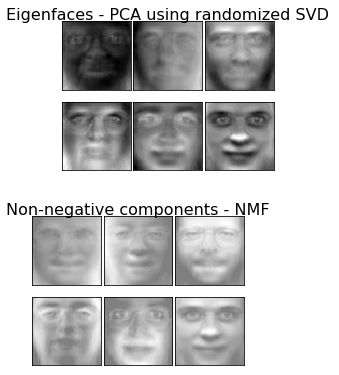数据降维笔记——非负矩阵分解(NMF),人脸数据特征提取
数据降维——非负矩阵分解(NMF)
一、原理
Non-negative Matrix Factorization,实在矩阵中所有元素均为非负数约束条件之下的矩阵分解方法。
NMF能够广泛应用于图像分析、文本挖掘和语音处理等领域。
基本思想:给定一个非负矩阵V, NMF能够找到一个非负矩阵W和一个非负矩阵H,使得矩阵W和H的乘积近似等于矩阵V中的值。
V(F∗N)=W(F∗K)∗H(K∗N)
W矩阵:基础图像矩阵,相当于从原矩阵V中抽取出来的特征。
H矩阵:系数矩阵。
V(F∗N)=W(F∗K)∗H(K∗N)
矩阵分解优化目标:最小化W矩阵H矩阵的乘积和原始矩阵之间的差别。
1、基于欧式距离损失函数
2、基于KL散度的损失函数
具体求解方法:http://blog.csdn.net/acdreamers/article/details/44663421/
使用方法:
sklearn.decomposition.NMF加载NMF算法,参数:
- n_components:分解有矩阵单个维度k;
- init: W矩阵和H矩阵的初始化方法,默认"nndsvdar".
二、实例
Olivetti400*64*64人脸数据特征提取:
from numpy.random import RandomState
import matplotlib.pyplot as plt
from sklearn.datasets import fetch_olivetti_faces
from sklearn import decomposition
#图像展示的排列情况
n_row, n_col = 2, 3
#设置提取特征的数目为6
n_components = n_row * n_col
#人脸数据图片大小
image_shape = (64, 64)
# Load faces data,并打乱顺序
dataset = fetch_olivetti_faces(shuffle=True, random_state=RandomState(0))
faces = dataset.data
###############################################################################
def plot_gallery(title, images, n_col=n_col, n_row=n_row):
plt.figure(figsize=(1. * n_col, 1.26 * n_row))
plt.suptitle(title, size=16)
for i, comp in enumerate(images):
plt.subplot(n_row, n_col, i + 1)
vmax = max(comp.max(), -comp.min())
#对数值归一化并以灰度图形式显示
plt.imshow(comp.reshape(image_shape), cmap=plt.cm.gray,
interpolation='nearest', vmin=-vmax, vmax=vmax)
plt.xticks(()) #去除子图的坐标轴标签
plt.yticks(())
#调整子图位置及间隔
plt.subplots_adjust(0.01, 0.05, 0.99, 0.94, 0.04, 0.)
plot_gallery("First centered Olivetti faces", faces[:n_components])
###############################################################################
estimators = [
('Eigenfaces - PCA using randomized SVD',
decomposition.PCA(n_components=6,whiten=True)),
('Non-negative components - NMF',
decomposition.NMF(n_components=6, init='nndsvda', tol=5e-3))
]
###############################################################################
for name, estimator in estimators:
print("Extracting the top %d %s..." % (n_components, name))
print(faces.shape)
estimator.fit(faces)
components_ = estimator.components_
plot_gallery(name, components_[:n_components])
plt.show()
Extracting the top 6 Eigenfaces - PCA using randomized SVD...
(400, 4096)
Extracting the top 6 Non-negative components - NMF...
(400, 4096)
输出结果:



